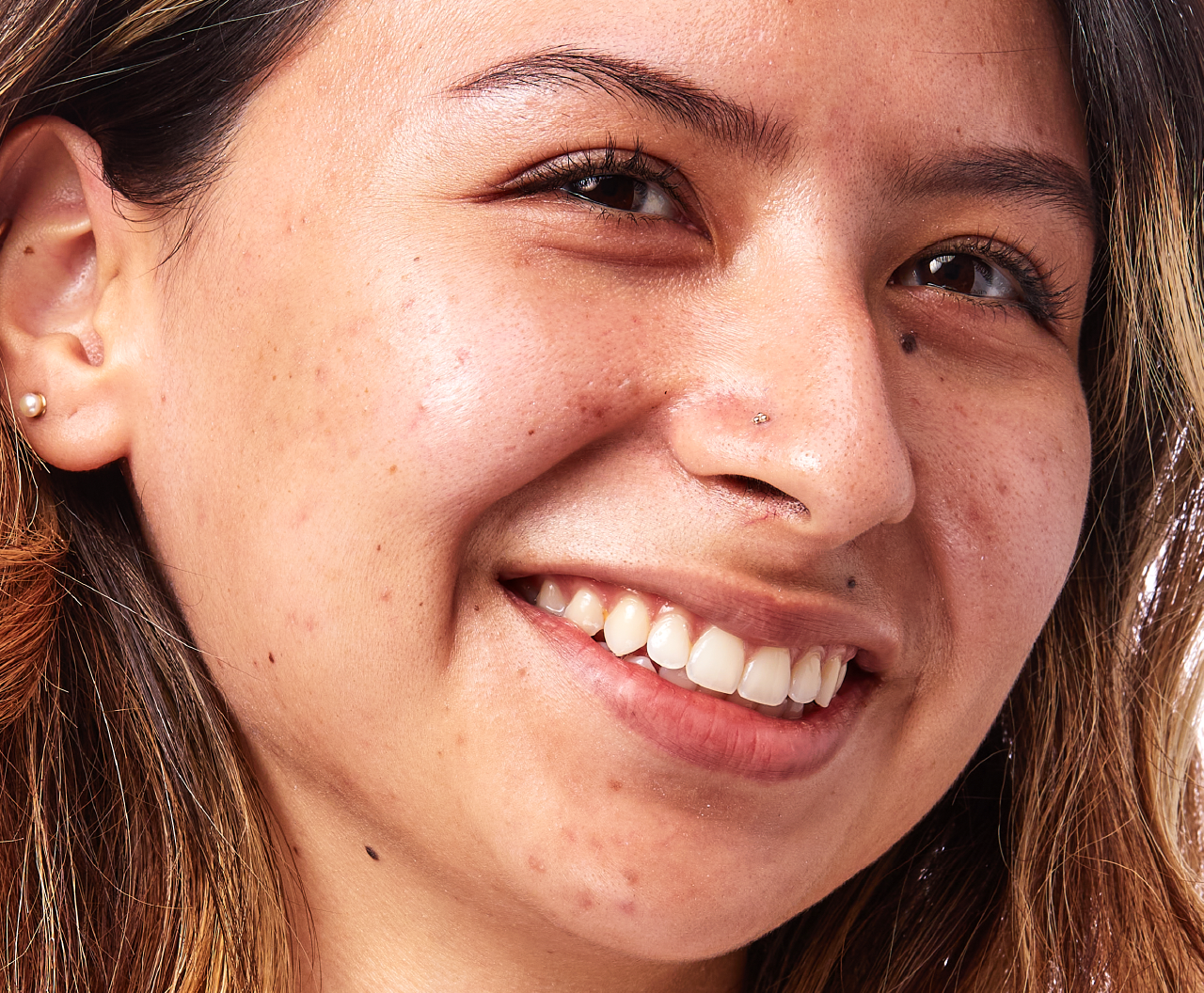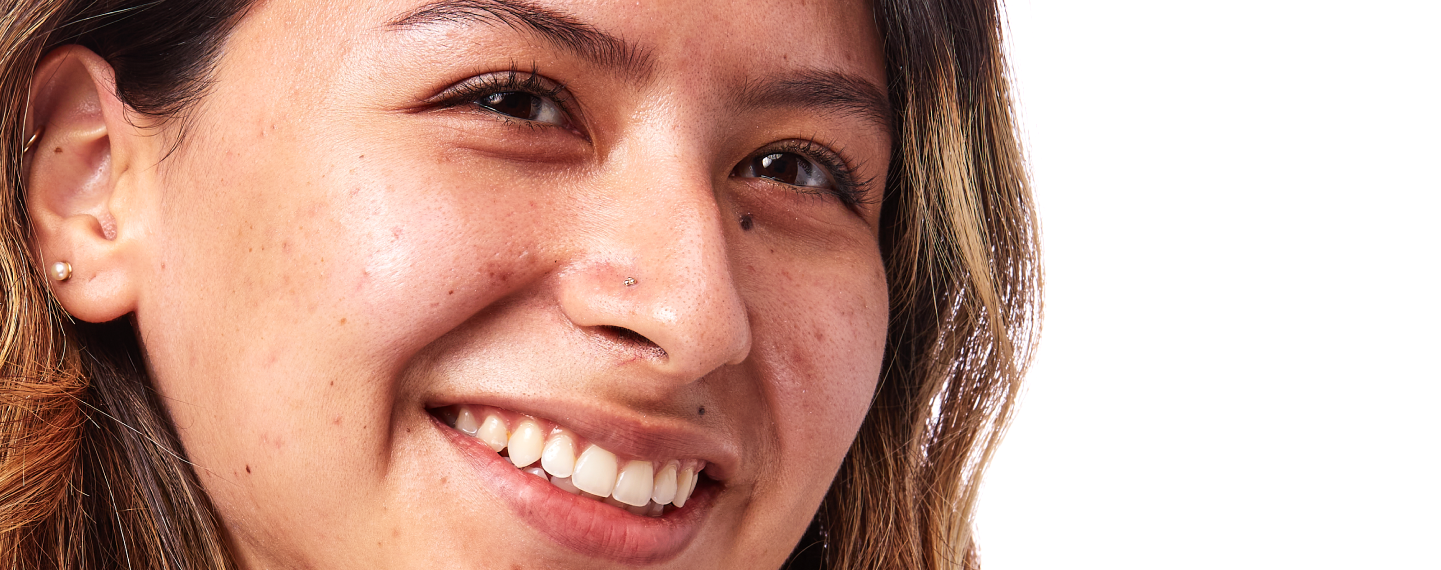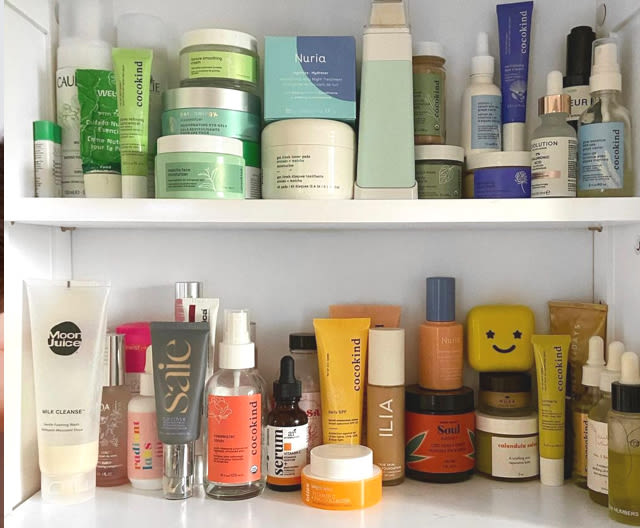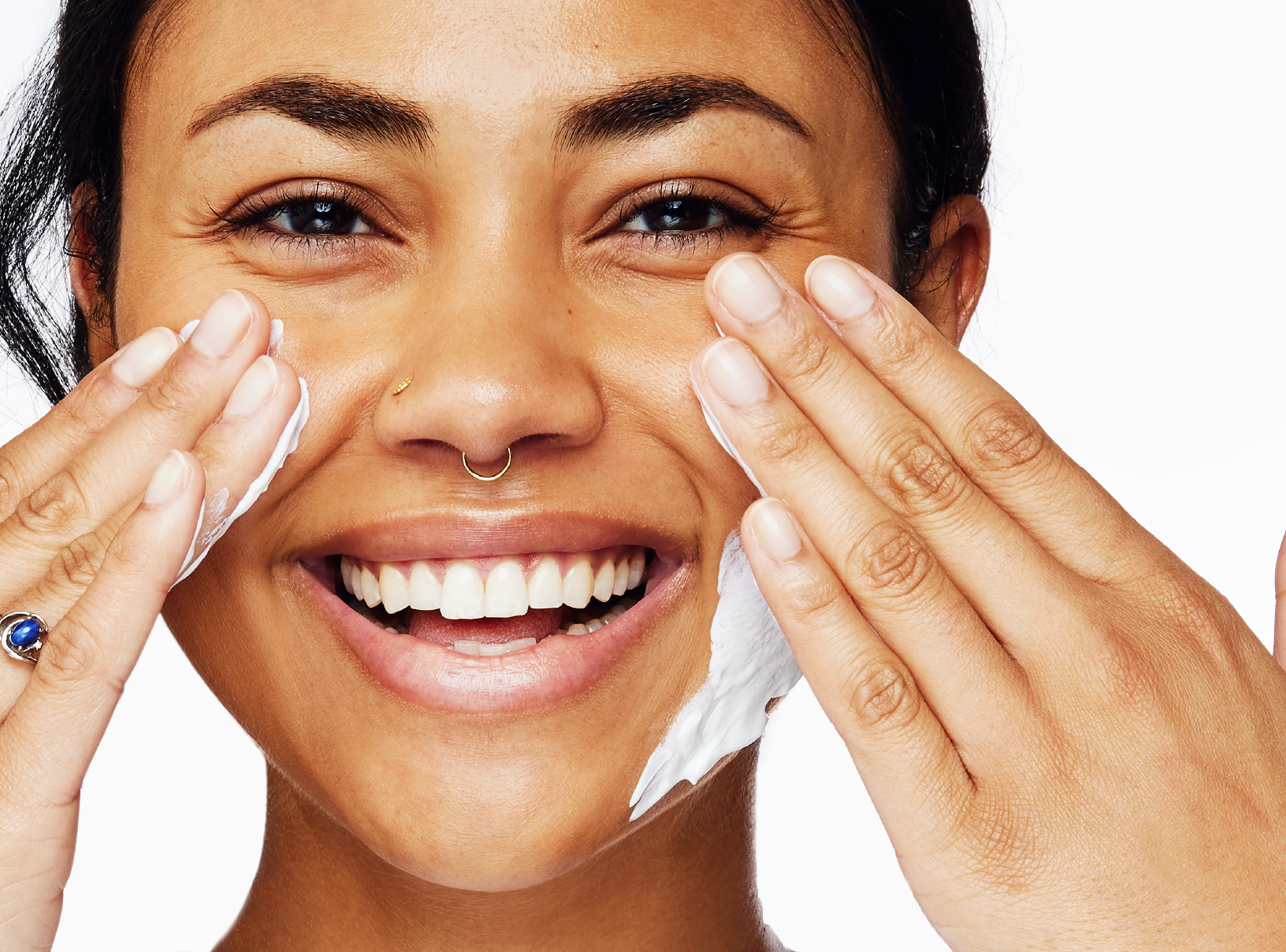Education
How to minimize your pores


SHARE
Education
How to minimize your pores
Medically reviewed by Vicky Davis, FNP
Written by Apostrophe Team
Last updated 4/1/2024
Large pores are a common annoyance that can affect your skin’s feel and texture. Although you can’t totally get rid of your pores (they’re kinda important, you know), there are many things you can do to make them smaller and less visible. From picking a good quality cleanser and pore-minimizing products to switching to new makeup, read on to discover the best ways to reduce the appearance of pores.
What Causes Large, Visible Pores?
Your pores, or hair follicles, play an important role in keeping your skin healthy. Inside each pore is a sebaceous gland that secretes sebum — a natural type of oil that keeps your skin lubricated, moisturized, and protected from damage. While some sebum is vital for your skin’s appearance and function, when your pores secrete too much sebum, it can mix with dead skin cells and cause your pores to clog and expand. This is what causes acne breakouts, as well as the large, clearly visible pores that can show in certain parts of your face. You may be more prone to visible pores if you have naturally oily skin, which can contribute to blockages and comedones. Everyone’s skin is different, of course, and while you can’t choose your skin type, you can definitely reduce the appearance of larger pore size and give your skin a smoother, more consistent texture.
8 Ways to Minimize the Appearance of Your Pores
Although large pores can be annoying to deal with, there are numerous ways you can make them less obvious. We’ve shared eight options below — many of which you can do at home to minimize the appearance of large pores and improve your skin’s texture.
Use a Good Quality Facial Cleanser
One of the most effective ways to make your pores less visible is to wash your face with a good quality cleanser. Cleansing helps to remove excess sebum, skin cells, and other substances that can clog pores and cause them to visibly expand. As a bonus, washing your face also helps to reduce your risk of getting comedonal acne lesions such as whiteheads and blackheads. For best results, use a gentle, fragrance-free cleanser. Wash using warm water and apply the cleanser with your fingertips. Make sure not to scrub your face, as this can contribute to skin inflammation. Dermatologists typically recommend cleansing in the morning and in the evening to reduce oiliness and further prevent blockages.
Switch to Non-Comedogenic Makeup
An easy way to reduce the look of clogged, expanded pores is to prevent them from appearing in the first place. In addition to cleansing your face, you can do this by avoiding makeup and skin care products that contain pore-clogging oils and other ingredients. When you’re shopping for makeup, moisturizers, and other skin care products, look for products that are labeled “oil-free” or “non-comedogenic.” These products typically contain fewer oils and other ingredients that can cause clogged pores or acne. As well as switching to non-comedogenic makeup, try using a less-is-more approach to makeup in general. Trying a "minimal makeup" look gives your skin a break and may help to reduce the look of your visible pores.
Use AHAs or BHAs to Exfoliate at Home
There are two main culprits behind clogged pores. The first, as we’ve already covered, is sebum — the natural oil that’s secreted by your sebaceous glands. The second is dead skin cells, which can build up on the outer layer of your skin as the result of a process called epidermal turnover. Over time, your skin naturally replaces itself by generating new cells. And as these cells build up on the surface of your skin, they can mix with sebum to clog and expand the look of your pores. To prevent dead skin cells from enlarging the look of your pores, try adding alpha-hydroxy or beta-hydroxy acids, or AHAs and BHAs, to your skin care routine. AHAs and BHAs are exfoliants and work by stripping away dead cells in the outermost layer of your skin. This can improve your skin’s texture and make wrinkles, age spots and other signs of aging less noticeable. By removing leftover cells, AHAs and BHAs may also help to prevent your pores from looking enlarged and visible. Common AHAs include glycolic acid, lactic acid, and mandelic acid, while the most well-known BHA is salicylic acid. You can find AHAs and BHAs in countless over-the-counter skin care products, including facial cleansers, masks and serums.
Use Tretinoin to Prevent Clogged Pores
Another option for removing dead skin cells and preventing clogged pores is tretinoin, a topical prescription retinoid. Tretinoin works by promoting skin cell turnover, meaning it allows your skin to create new cells at a faster pace than normal. This promotes the removal of dead skin cells and helps to unclog your pores. As skin care medications go, tretinoin is as versatile as it gets. In fact, it’s approved by the FDA for treating acne, skin texture, facial wrinkles, and hyperpigmentation — a condition in which some patches of skin become darker than others. By promoting dead skin cell shedding, tretinoin may help to reduce blackheads and reduce the look of enlarged pores that can affect your skin’s appearance and texture. Tretinoin can take a few weeks to start working, during which you may develop irritation and dry skin. If you find that tretinoin makes your skin dry, try applying moisturizer before and after tretinoin to minimize this side effect. Tretinoin is an ingredient that could be in your Apostrophe topical treatment, which is available following a consultation with a healthcare provider who will determine if a prescription is appropriate.

PRESCRIPTION TRETINOIN
Target acne, dark spots, and signs of aging with this science-backed ingredient.
Consider an Over-the-Counter Retinoid
If you’re looking for something milder than tretinoin but with similar effects, you may want to try an over-the-counter retinoid. Retinoids like adapalene and retinol both belong to the same class of medications as tretinoin, but are milder on skin, and don’t require a prescription. They’re easy to find in over-the-counter serums, creams, and gels, making them good first options for dealing with larger pores. Like tretinoin, over-the-counter retinoids may cause mild dryness and irritation, although these issues generally fade over time. While over-the-counter retinoids are gentler on the skin, the results you'll see with these ingredients are typically not as dramatic as results from tretinoin. To get the best results from retinoids, try applying them just before you go to bed.
Avoid Popping Pimples or Squeezing Pores Yourself
When you see a clogged, enlarged pore, it can feel tempting to pop your pimple at home. Doing this isn’t recommended, as trying to extract clogged pores on your own can potentially result in scarring and infections — both of which can make your pores even more obvious. Instead of relying on your fingers or pore strips, think long term and use your cleanser, retinoids, and other products to clear out your pores. Alternatively, you can try one of the treatments listed below for quick, effective results.
Consider Cosmetic Treatments for Stubborn Pores
If retinoids, hydroxy acids and other topical treatments aren’t effective, you may want to try a cosmetic treatment to make your pores appear less visible. Dermatologists and plastic surgeons offer several treatments for the appearance of large pores, including acne extraction, microdermabrasion, and chemical peeling. Acne extraction involves physically removing the contents of clogged pores from your skin. It’s performed using sterile instruments and is typically used to get rid of large, obvious blackheads and other forms of acne. Microdermabrasion involves carefully removing the outermost layer of your skin using a special minimally abrasive instrument. It’s used to improve the skin’s texture and reduce the look of wrinkles, fine lines, and enlarged pores. Chemical peels involve using a chemical solution — usually a form of acid — to carefully remove the damaged outer layers of your skin. Like microdermabrasion, chemical peeling helps to treat skin imperfections, wrinkles, and sun damage. Cosmetic procedures can produce real results, but they’re often expensive and may need to be repeated for sustained improvements.
Protect Your Skin from the Sun
Spending too much time in the sun can take a serious toll on your skin. In fact, according to the Skin Cancer Foundation, sun exposure is responsible for up to 90 percent of the visible changes that occur in our skin as we get older. When you spend time in sunlight, your skin is exposed to UV radiation, which can damage it at the DNA level. This breaks down collagen and makes your skin less elastic, causing fine lines, wrinkles, and other skin concerns to become more obvious. As your skin loses some of its elasticity, issues such as large pores can also start to show more easily. The best way to minimize UV damage is to prevent it from happening. You can do this by using SPF 30+ broad-spectrum sunscreen whenever you spend time outside, and by protecting your skin with a hat and sunglasses. If you're looking for a derm-approved SPF, get our best-selling sensitive face sunscreen, 'Screen. Not only does protecting your skin from the sun help to minimize the look of large pores — it’s also a helpful way to avoid wrinkles and discoloration, and helps you maintain proper collagen production.
A Final Note on Large Pores
With the right combination of habits and skin care products, it’s possible to make large, obvious pores appear smaller and harder to see. And in this way, you’re minimizing the look of your pores. If you’re looking to improve your skin’s health, appearance, and texture, science-backed skincare ingredients like those found in Apostrophe topical treatments can help. With this said, it’s important to keep in mind that your pores are a vital part of your skin, and that there’s no way to truly change the size of your pores. Try to avoid comparing your skin to what you see in filtered photos — and know that pores and other skin concerns are both natural and very normal. Looking for more skin care help? Our guide to building a skin care routine discusses everything you need to know about creating a solid skincare routine, from selecting the right products for your skin type to maintaining healthy skin throughout the day.
11 Sources
Hoover, E., Aslam, S. & Krishnamurthy, K. (2020, October 26). Physiology, Sebaceous Glands. StatPearls. Retrieved from https://www.ncbi.nlm.nih.gov/books/NBK499819/
What Can Treat Large Facial Pores? (n.d.). Retrieved from https://www.aad.org/public/everyday-care/skin-care-secrets/face/treat-large-pores
Koster, M.I. (2009, July). Making an epidermis. Annals of the New York Academy of Sciences. 1170, 7–10. Retrieved from https://www.ncbi.nlm.nih.gov/pmc/articles/PMC2861991/
Moghimipour, E. (2012, Winter). Hydroxy Acids, the Most Widely Used Anti-aging Agents. Jundishapur Journal of Natural Pharmaceutical Products. 7 (1), 9–10. Retrieved from https://www.ncbi.nlm.nih.gov/pmc/articles/PMC3941867/
Zasada, M. & Budzisz, E. (2019, August). Retinoids: active molecules influencing skin structure formation in cosmetic and dermatological treatments. Advances in Dermatology and Allergology. 36 (4), 392–397. Retrieved from https://www.ncbi.nlm.nih.gov/pmc/articles/PMC6791161/
Tretinoin Topical. (2019, March 15). Retrieved from https://medlineplus.gov/druginfo/meds/a682437.html
Yoham, A.L. & Casadesus, D. (2020, December 5). Tretinoin. StatPearls. Retrieved from https://www.ncbi.nlm.nih.gov/books/NBK557478/
Pimple Popping: Why Only a Dermatologist Should Do It. (n.d.). Retrieved from https://www.aad.org/public/diseases/acne/skin-care/popping
Microdermabrasion. (n.d.). Retrieved from https://www.plasticsurgery.org/cosmetic-procedures/microdermabrasion
Chemical Peel. (n.d.). Retrieved from https://www.plasticsurgery.org/cosmetic-procedures/chemical-peel
Skin Cancer Foundation. (2019, January 10). Photoaging: What You Need to Know About the Other Kind of Aging. Retrieved from https://www.skincancer.org/blog/photoaging-what-you-need-to-know/
Like what you just read? Sign up for our email list to get the scoop on skincare science delivered straight to your inbox.

Education
What is milia?
What is milia? Today, we’re jumping into one type of bump that you may have heard about most commonly in infants — milia.
Read More
Education
Best moisturizer for acne-prone skin
If you have combination acne-prone skin, figuring out which moisturizer is best for your skin might be tough. In this guide, we break down the best moisturizer for combination, acne-prone skin.
Read More
Education
How to build a face care routine
As you get into skincare, it might seem overwhelming, especially trying to figure out the order you're supposed to apply products in. Below, we detail how to build a face care routine for your skin!
Read More